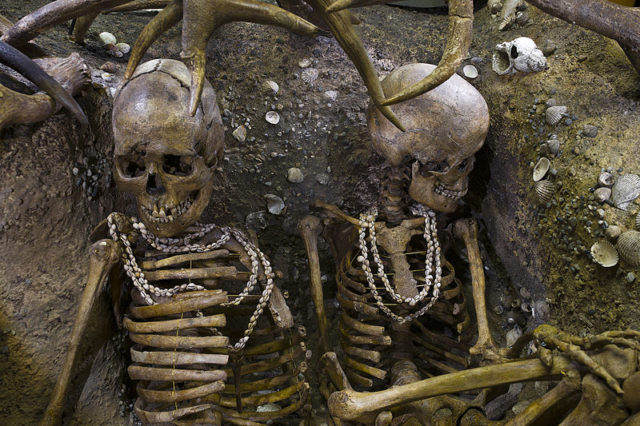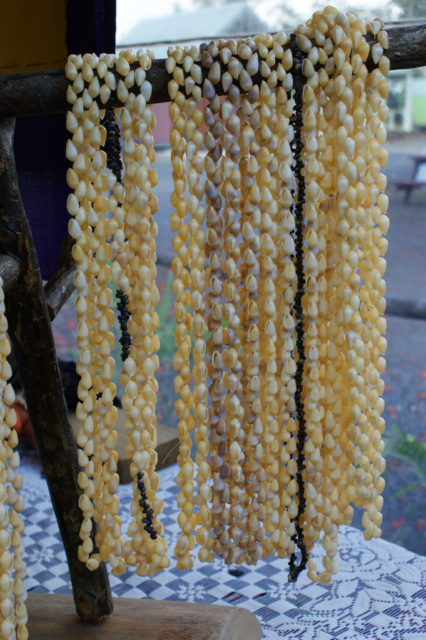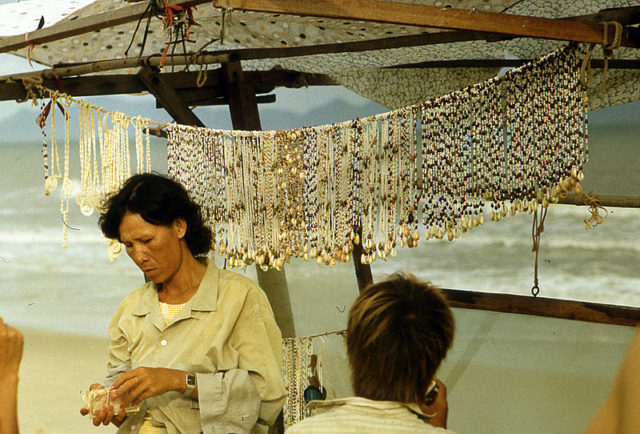Humans love personal ornaments. Necklaces, bracelets, earrings, and rings have always been popular with both men and women.
Nowadays, gold, silver, platinum, and other alloys, as well as precious and common stones make up most of the jewelry found in stores all over the world. A diamond ring is the most common representation of an engagement, and diamonds are also popular in other types of jewelry.

People decorate themselves, their children, and even their pets. Newly popular is body piercing which allows jewelry to be worn on any part of the body. In the past, less expensive metals such as brass were used for wedding rings and other jewelry for the common population. Copper jewelry came into use about 7 thousand years ago but jewelry made from seashells, however, are the oldest examples; they date from over 100,000 years ago.
The oldest known, single piece of jewelry, discovered in Israel in the 1930s, is made up of shells from a type of sea snail called the swollen nassa, which belongs to the mollusk family. Recently, these were carbon-dated to between 100,000 and 135,000 years ago. Shells found in Oued Djebbana, Algeria, were tentatively dated to 35,000 years ago and could be as old as 90,000 years. Researchers found man-made holes in jewelry made from shells of mud snails, the saltwater clam, and the bittersweet clam, also part of the mollusk family, that were discovered at Middle Paleolithic archaeological sites. Experts believe shells may have been traded or possibly used as currency, as the examples found in Algeria originated in an ocean over 100 miles away.
When humans migrated to Europe and Asia, shell jewelry moved with them. So too did ornaments made from animal antlers, teeth, bones, and ivory strung on animal sinew. Shells that are commonly found are the dwarf turban, flat periwinkle, the Cyclopes genus of sea snails, the mutable nassa, and the swollen nassa. Fossil shells were also used and were sometimes painted with natural dyes. Additionally, some examples of mother-of-pearl and abalone have been found in archaeological digs.
A carved shell pendant found in North Yorkshire, England, in 2015, is thought to be from around 11,000 BC and is possibly the oldest Mesolithic art found in the British Isles. In southern Russia, excavators found bracelets made of mammoth tusk with fine engravings in the ivory.

The Venus of Schelklingen, a small statuette made from the tusk of a mammoth found near the Black Forest area in Germany, was dated at 35,000 to 40,000 years ago. The University of Tübingen sponsored the excavation led by archaeology professor Dr. Nicholas J. Conard. The figurine was found in several pieces in an underground cave; all of the pieces were recovered except the left arm and shoulder.

Conard’s team determined that it is probably a fertility idol. A small, protruding circle on the top allows the amulet to hang around the neck. It portrays a figure of a well-endowed woman and is anatomically correct. According to the New York Times, Dr. Conard wrote, the idol “radically changes our view of the origins of Paleolithic art.” The statue portrays a human female and is the first of its kind in ancient art.
A flute carved from bone was also found in the cave, leading scientists to believe art and music were important in human lives long before they originally thought. Today, shells are still used in jewelry and are usually found at tourist sites near the ocean. The same types of shells are used, but they are bought in stores and often made in factories rather than fashioned by hand, as the ancients once did.
